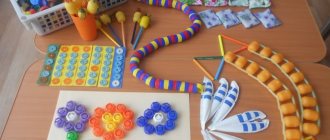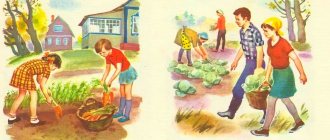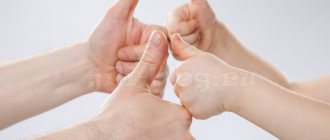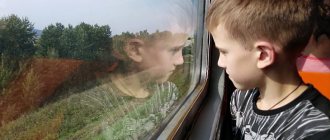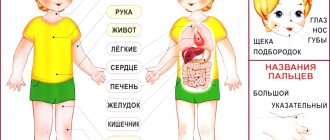The question of what to do with a child at home while the family is forced to quarantine is relevant for many parents. Back in 1995, the magazine “My Baby and Me” collected ideas on how to entertain kids so that they wouldn’t get bored. We offer you these games, crafts and activities for children from 2 to 7 years old. Catch the list of ideas!
Games for children from 2 years old
Hiding the candy . All but one player leaves the room. The remaining one hides a few candies, then calls the others again. The one who finds the most candies wins.
We make boats . We make boats from walnut shells: a little plasticine inside, stick a toothpick in, and glue triangular sails from paper onto it. We let the boats float in a basin or in a bathtub. We blow on them in different directions.
Mother and child (father and child). With a reversal of roles: adults play children and vice versa.
Domino ribbon . We arrange the dominoes one after another into a long ribbon, placing them on a short edge. When the tape is ready, we push the first domino and all the dominoes fall, overturning one after another.
We look at the photographs . We take out old albums. We come up with and tell stories to accompany the photographs.
We destroy the tower . We build a tower from boxes or cubes. From some distance we try to destroy it with a ping pong ball.
Horse racing . We ride on a tightly inflated balloon until it bursts.
Skittles . We place cubes or skittles on the carpet and knock them down with a tennis ball.
We are building a house . Cover the table with a large tablecloth or blanket. We climb under the table. The main thing is not to forget provisions.
Speedwalking competition . Everyone puts on very large shoes and runs a race through the entire apartment.
We sort the cubes (can/bottle lids) . We sort all the cubes by color and shape.
We are looking for pictures . The participant in the game looks for a picture in an illustrated book. Names one of its characteristics. Others have to guess.
Witch game . We lay out a circle from the rope. This is a witch's house, in which one of the players - a witch - lies in wait for prey. The rest are crawling around the witch's house. When the witch comes out, everyone runs away very quickly.
Dog game . One player is chosen as a dog. Others lead him on a leash throughout the apartment.
We give names . We come up with some funny name for each finger. We come up with short stories about them.
Sitting football . Two players sit opposite each other and play with a ping pong ball with their feet.
Let's play traffic . Using a thick brush and paints, we draw streets on a large sheet of paper. When the paints are dry, we begin driving the toy car around the roads.
READING AND WRITING
Your child will need these skills in school. After all, the first thing he will have to master by first grade is reading and writing.
In the fifth year, you need to plan lessons with your preschooler to prepare your hand for writing. Here you will already need the first teaching aids - children's copybooks. These are excellent “developers” for the hand, helping the child develop the necessary muscles so that the hand does not get tired while writing. In children's copybooks, the child is asked to trace simple patterns point by point and then reproduce them independently.
To reinforce the perception of the first sound in a word (the entire study of letters is based on this), you can glue cards with images of letters to different objects in the house. Let the child determine in which case the card is glued correctly and in which case it is not.
When teaching preschoolers to read, more and more mothers choose Zhukova’s primer. It consistently shows how letters “merge” into syllables and gives important recommendations to parents. In addition, Zhukova’s teaching methods meet the requirements of school curricula.
Advice
Before you start teaching your child to read, teach him to hear all the sounds in words, in different parts of the word (at the beginning, middle, end), and also to isolate syllables in words. You can find many entertaining games for this.
Only with this approach will the child learn to read and write without errors (children often transfer into writing what they hear or perceive incorrectly).
Games for children from 3 years old
Omelette. Cut out a circle the size of a plate from yellow colored paper and fold it in half. This is an omelette. We fill it with various little things (for example, old photographs, unexpected pictures, fragrant flower petals, raisins or coins for good luck). We serve the omelette on a plate and treat each other.
We empty our wallet. We pour all the coins from the wallet onto the table and sort them.
Let's hum. One of the players begins to hum a melody. Others should recognize her.
Birds fly high. Players drum their fingers on the edge of the table. Everyone takes turns naming an animal. If it flies, everyone raises their hands; if it doesn’t fly, they continue to drum. If someone makes a mistake, he gives away his forfeit.
We draw on fabric. We use textile paints to paint fabric, for example, an old T-shirt or a sheet.
Blind chicken. With our eyes closed, we try to walk from one room to another without hitting anything.
Laughing is prohibited. We are trying to make our friend laugh by telling him all sorts of nonsense. His job is to stay serious. Who will last longer?
Running with an “egg”. We put a ping pong ball on a teaspoon and run around the entire apartment, trying to keep the ball on the spoon.
Chatterboxes. Let's talk quickly. Who can do it longer?
We glue the collage. We tear newspaper or magazine pages into pieces. From this we glue a colored collage.
Who will blow next? We blow on the bottle caps so that they fly off as far as possible.
Blot pictures. Spray ink onto paper. Fold the paper with the blot inward, then unfold it again. Draw a picture from the prints.
We depict a snake . The more players, the better. We run around the apartment one after another, doing the same movements. The guide tells the players what they should do, such as crawl around the table or tumble around the room.
“Inflating” the pictures. Spray different paints on the paper, adding more water. Blowing through a straw produces multi-colored spots.
We dress up thematically. Prince and princess: We glue crowns from gold paper and put on a cloak. Astronaut: we make a helmet from a cardboard box, an oxygen tank from plastic bottles. Firefighter: colander as a helmet, dad’s jacket and belt, vacuum cleaner hose, etc.
Veterinary hospital. We put soft toys in bed and treat them: bandage them, give medications, measure the temperature, apply compresses, etc.
Let's keep our balance. With arms extended to the sides, we walk, like a tightrope walker, along the very edge of the carpet or a jump rope stretched out on the floor.
We score goals. Place the pan on the floor. Or we use bottles to mark gates on the floor. From a certain distance we throw ping-pong balls. Each hit earns a point.
Forfeit. We collect forfeits from the players. We ask others: “What should the player who owns this forfeit do?”
Let's play ice cream parlor . Fill a yogurt cup with fruit juice, yogurt, etc. and freeze it. Decorate the ice cream and serve.
Ping pong in the room. We sit on the floor. Using cardboard, hit the ping pong ball against the wall.
MUSICALITY, SENSORY, MOVEMENT
One of the main factors in the proper development of a preschooler at this age remains movement. He must move a lot. This increases his agility, endurance, coordination, develops muscles, and strengthens the skeleton. Therefore, the lesson program should have a lot of space for gymnastics, dancing, exercises, cycling, and all kinds of outdoor games. You can enroll your preschooler in some sports section.
And if motor activity is accompanied by well-chosen melodies, the child will also receive musical development. He will have an improved sense of rhythm, perception of fast and slow music, sad and cheerful.
Advice
At this age, a preschooler can be given to listen not only to children's melodies, but also to classical ones. He already has his favorite tunes, to which he begins to dance or hum.
Sensory perception is, first of all, the development of tactile sensitivity. The baby should have the opportunity to touch a variety of materials and textures: soft, hard, smooth, rough, fluffy, prickly, warm, cold. A good game is to recognize objects by touch without seeing them (for example, by taking them out of a bag).
Improving fine motor skills plays an important role. This helps improve all mental abilities: thinking, speech, memory. In addition, good fine motor skills prepare the hand for writing: the child will hold the pen correctly, the hand will strain and get tired less. Games with small objects and materials are good for this purpose: cubes, construction sets, mosaics, sand, cereals. This also includes finger games, tying shoelaces, fastening zippers, unscrewing corks, drawing, appliqués, and modeling.
Games for children from 4 years old
We dress up the dolls. We make outfits for dolls from scraps. We fasten with ribbons or paper clips.
Throwing up a balloon. Throw a well-inflated balloon into the air. You need to push it up with your index finger, preventing it from falling.
We crawl on our backs. We lie on our backs and move around the room, trying not to touch anything.
We come up with hairstyles. We bring bows, barrettes and hair hoops. We give each other unusual, fantastic hairstyles.
Scratched pictures . We paint the surface of the paper with colored wax pencils, and on top with black paint. Using some object, we scratch various squiggles and lines so that the colored base appears through the black background.
We tell stories. One begins to tell a story. In the middle he is interrupted, and the next one must continue the story.
Drawing musical pictures. Let's turn on the music. On a piece of paper we draw colorful shapes that are associated with music.
Folding pictures. We draw a head on paper, bend it back and pass it on to someone else, who draws the stomach and arms and bends it back again. The next one finishes drawing the legs and feet. Expand and look at the drawing.
We count the points . We throw the dice one by one and count. The one who scores more points wins. You can draw a circle on paper with a felt-tip pen and throw peas or seeds over it from a small height. We only count those that are in the circle!
Let's guess the sounds. One player closes his eyes and tries to guess which of the other players just snored, grumbled or meowed.
Learning to jump. Jump on one leg for as long as possible. On two legs in place, “backing up”, etc.
Figure-rug. Using trousers, a shirt and boots, we lay out a figure on the floor. Draw a face of suitable size on paper, cut it out and apply it.
Finger caps. From the circles we glue our own pointed hat for each finger.
We flip the coin. Two players place a coin on the table and use their finger to shoot the coin from one to the other.
I see something that you don't see. We wish for some colored thing in the room. We name the color and ask you to guess this item.
We think quickly. One player quickly names a word. The other person should immediately say what came to his mind in this regard. Then we change roles.
Let's put on makeup. We paint our faces with mom’s cosmetics (or gouache, but we don’t do that for long!)
We make wishes about people. We look out the window. We come up with various stories about the people we see below.
Ghost game. Everyone wraps themselves in white sheets and circles around the apartment like ghosts, making terrifying sounds.
Making a picture book. Cut out pictures from a catalog or magazine. Glue it into a notebook and decorate the cover.
Let's play robbers. We hide several objects in the room that are in their usual places. Players returning to the room must guess what has disappeared and find it.
Magnet game. Place a magnet under the paper and a coin on the paper. Use a magnet to move the coin along the paper.
Drawings continued . Place a red dot in the center of the sheet of paper. We invite the next person to continue the drawing with a dot or line. Then the turn goes to the first player.
When mom is busy
What to do with a child when mom needs to do regular housework and can’t pay attention to the game? If you show a little ingenuity, you can come up with a lot of things that the baby can do on his own, not only without distracting his mother, but also feeling like her indispensable assistant:
- introduce him to cooking: ask him to wash vegetables or fruits, stir the salad in a bowl, put sausage on sandwiches;
- let him help set the table: lay out spoons, napkins, bread, put out a salt shaker;
- when mom works with dough, a small piece of it can become an excellent material for a young sculptor;
- during cleaning, a little helper can be assigned, for example, to sort laundry for washing, wipe dust from low shelves, sort toys in the nursery: arrange cubes, pencils, construction parts, books into proper boxes, water flowers on the windowsills;
- you can invite your child to tinker with the products (peas, beans, pasta) - let him sort them or post a picture;
- A child can feel like an adult if he is offered to “cook” something from real products in “adult” dishes;
- You can ask the baby to make beads for mom (let him string bagels, large beads on a string, or attach clothespins).
To find an interesting and useful activity for your child, you don’t have to constantly play with him, sit him down with gadgets, or come up with something unthinkable. A little imagination and patience from adults - and the issue will be resolved to the benefit of both parties.
Games for children from 5 years old
Stringing hearts. Cut out hearts from colored paper. We make a hole in each heart and string it on a cord. We hang the chain.
Outline the hand. We place our hand on the paper. Draw along the outline with a pencil. Cut out and paint with colorful patterns.
Let's draw little people. We wet our finger. Then we dip it in ink and press it to the paper. We draw a little man from the print: we finish drawing the face, arms and legs.
We put up gates from bottle caps. We install a corridor of several gates. To do this, we put two caps together. We push the coins through the gate with our finger.
We count cars. We look out the window. We make a bet on how many cars (or how many cars of a certain color or model) will pass by the house over a period of time.
Guessing the animals . Each one depicts an animal. Others must guess which one.
Game of steps. We climb the stairs step by step. We come up with a name for each new step.
Toy money. We put the coins under the paper. Using a soft pencil, rub over the coin. We cut out paper money.
Swing. One lies down on the blanket, the others lift it higher and swing it.
A room out of a box . We make a room out of a cardboard shoe box. We draw furniture on paper, cut it out and paste it into the box.
Matchbox beds . We make cribs from matchboxes, and cut out suitable size pillows and blankets from paper. We draw little people on paper, cut them out and put them in bed.
We make paper animals. We draw any animals on thick paper. Cut it out. Glue a strip of cardboard as a stand.
Mosaic . Cut out a rectangle from paper. Then cut it into 10 pieces of different shapes. Mix the pieces. You need to make a rectangle out of the pieces again.
What is important to pay attention to?
The first thing that comes to mind for many parents is to sit the baby in front of the TV, computer, or give him a tablet or phone: interesting cartoons or games can captivate the child for a long time. But it should be remembered that the time of such leisure should be very, very limited, otherwise there will be much more harm for the child than good.
In order not to harm the baby, but to make his leisure time productive, it is important to take into account his age and individual abilities and needs.
- Most of all, four-year-olds love play activities. Any activity aimed at developing important areas of a child’s life should be transformed into play.
- The baby requires physical activity for the proper formation and strengthening of muscles, tendons, bones, and the cardiovascular system.
- He needs the opportunity to actively learn about the world around him and its laws.
- Classes to develop speech and enrich the child’s active vocabulary are of great importance.
- It is necessary to improve everyday skills.
- The game should instill in the child a culture of behavior and communication.
- It is necessary to use the imagination of the young naturalist.
- Any creative activity is relevant. It develops logic, motor skills, and imagination.
- The child strives to actively communicate with other children of his age, so this opportunity for his life experience should be provided. First of all, through role-playing games.
- In a playful way, the baby should take part in the daily activities of the parents as much as possible.
Based on this, the child’s activities should be very diverse. The following are specific examples of what you can do at home with a 4-year-old child.
Gender differences in the development of preschool children
Differences in the development of boys and girls become most noticeable by the age of four.
Girls' areas of interest include people, relationships between people, the organization of everyday life, and beautiful household items. Boys are trying to transform the existing order.
In relation to things, girls quickly begin to understand their utilitarian meaning. Boys are interested in the structure of each item and the ability to use it for other purposes than its intended purpose. As a rule, many boys are not particularly thrifty with things.
When included in activities, girls do so actively. The boys are getting ready. Girls ask questions during play with a desire to communicate, and boys ask questions to get the information they need. Girls are more fond of games associated with guardianship, a desire to help, and with an educational function. Boys' favorite games are active, without relying on rules.
Construction. Girls usually act according to a model, unlike boys who constantly fantasize, transform and invent everything.
In speech, girls more often use nouns and adjectives, and boys use verbs and interjections.
Studying the characteristics of children's thinking, researchers noted the main gender difference in the structure of the brain. Girls have a more developed left hemisphere, which is responsible for the development of oral and written speech. In boys, it is the right, which is responsible for spatio-temporal representations. The development of girls is characterized by a predominance of visual-figurative thinking, and for boys - abstract thinking. Girls' memory is long-term, while boys' short-term memory prevails.
Rules for organizing children's physical education
Due to rapid growth and high energy expenditure, a baby aged 3-5 years quickly loses his baby fat and acquires “adult” proportions. Before introducing physical exercise, it is necessary to establish a clear daily routine. The baby should eat often and in small portions. Go to bed in a well-ventilated area, go to sleep and get up at about the same time. At the age of 3-5 years, a little person still needs a nap of about 2 hours during the day.
During the walk, children should walk for 15-20 minutes at a time, after which they need to take rest breaks.
Attention ! The child will get used to physical education faster if he sees the example of loved ones - grandmothers, parents, especially since children strive to imitate in everything.
During this period, children still cannot hold attention for a long time. You can concentrate on the exercises for no more than 10-15 minutes. After such a short lesson there must be a pause for active games that require a lot of movement. The load needs to be increased no more than once every 2-3 months.
If possible, you should add swimming to your activities.
During illness, all physical education activities are stopped. You can only return to them:
- 7-14 days after suffering from acute respiratory viral infection,
- 3 weeks after adenoviral infection or severe infectious disease.
In general, you should rely on the opinion of your pediatrician about when to return to gymnastics. Restore the load gradually.
IS THERE A MANDATORY STANDARD?
The state does not impose special requirements for the preparation of young children. The federal standard contains only general guidelines towards which preschool education should be directed. These are the simplest self-service skills, activity, the desire to imitate adults and peers, fluency in speech, and showing interest in culture and nature.
Another party that controls the development of a preschooler is a neurologist who monitors the baby from birth. The purpose of its monitoring is to track the manifestations of possible diseases, since even a slight delay in development can be their consequence.
Below is a list of characteristics that a child should have at 4 years old. It is compiled based on the general requirements that are usually presented to children of this age. Its points are a strong recommendation, but not at all a binding law. The main thing is to awaken the child’s interest in development and support his interests, giving them a constructive direction.
If it seems to you that your baby is lagging behind in some way and you want to “pull him up,” be patient and imaginative. The most reliable method for teaching a four-year-old is through play. It is advisable to teach all skills and abilities through play and creative exploration, using fun lessons, directing the child’s positive energy to cognitive activity.
Try to ensure that developmental programs do not limit the natural cognitive aspirations of a growing child and do not match the curriculum at school. If a child in the first grade is bored in class, this will kill interest in learning and further problems with academic performance will begin.
